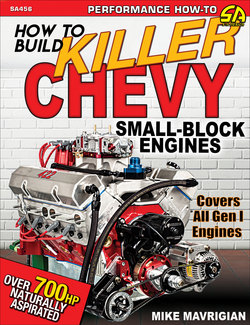Читать книгу How to Build Killer Chevy Small-Block Engines - Mike Mavrigian - Страница 9
На сайте Литреса книга снята с продажи.
ОглавлениеCHAPTER 4
CONNECTING RODS
Connecting rods are one of the most critical components for any performance build. They provide the connection between the crank and the pistons and must withstand compression force and the dynamics incurred during the transition between approaching TDC and leaving TDC. Tensile strength, rigidity, and weight considerations are key factors. For engines designed to produce high levels of both horsepower and torque, only high-quality aftermarket forged steel, aluminum, or titanium rods should be considered. Cast rods should be completely ignored.
Today’s aftermarket offers a mind-boggling selection of rods in terms of superior materials, design innovations, lengths, and bearing bore diameter sizes to accommodate any build that you desire.
Factory OEM rods in the past typically required machining or grinding to create a weight-matched set. Current aftermarket performance rods commonly require little, if any, weight corrections.
Rod Ratio
Rod ratio is the combination of crankshaft stroke and connecting rod length. The ratio created by this combination affects both performance and durability. Rod ratio needs to be considered. Rod ratio is calculated by dividing the rod length by the crank stroke. For example, if the crankshaft features a stroke of 4.000 inches and the rod length is 6.000 inches, 6.000 divided by 4.000 equals a 1.5:1 rod ratio.
By increasing the stroke or by using a shorter rod, the rod ratio decreases. If the stroke is reduced or a longer rod is used, the rod ratio increases. Changes in the rod ratio affect the operating angle of the rods, which in turn affect piston thrust load and friction between piston skirts and the cylinder walls. Generally speaking, for street and high-performance use, rod ratios in the 1.5 to 1.8:1 range are acceptable, and about 1.75:1 is considered by some as ideal. However, extreme performance applications sometimes use ratios as high as 1.9 to 2:1.
When generically discussing rod length, let’s compare 5.700-inch rods to 6.000-inch rods while keeping the crank stroke unchanged. A shorter rod causes the piston to spend a bit less time dwelling at top dead center (TDC). A longer rod causes the piston to dwell longer at TDC, resulting in greater combustion pressure. A 5.700-inch rod allows the piston to dwell for about 2 to 3 degrees at TDC, while a 6.000-inch rod allows the piston to dwell at TDC about 9 to 10 degrees. The longer dwell time with a longer rod helps to flatten out the torque curve an allows the use of a higher compression ratio on pump gas. A longer rod aids the engine to pull better in a high RPM range.
The use of a longer rod also allows the use of pistons with a shorter compression distance (distance from the wrist pin centerline to the dome), which allows for a shorter skirt length, reducing weight mass. In basic terms, a longer rod provides more torque at high RPMs and reduces friction due to the reduced operational angle compared to a shorter rod.
All things considered, what is the best stroke and rod length combination? It all depends on your objectives.
Both OEM and aftermarket blocks are available in standard 9.025-inch deck heights, in addition to a variety of tall-deck configurations. Using Dart as one example, deck heights of 8.850, 9.025, 9.325, and 9.500 inches are available.
When determining the rod length that fits your build, you must consider these factors:
• Block deck height
• Half of the crank stroke
• Piston compression height
The reason we are only concerned with half of the crankshaft stroke when determining rod length is because only the TDC location of the crank rod journal influences the placement of the piston dome relative to the block deck. So, if the crank features a 4.000-inch stroke, we only factor in one half of the total stroke, which in this case is 2.000 inches. The half-stroke dimension, coupled with rod length and piston compression height, combines to place the piston dome at the block deck, whether this is desired at zero or slightly below deck according to the builder’s plan.
While rod ratio is certainly a factor to consider, other factors, such as displacement, compression ratio, cylinder head flow, cam timing, and exhaust scavenging, play a bigger role.
